Stogie Spirits: Evan Williams Single Barrel Vintage 1998
2 Jul 2009
For me, the Evan Williams brand has always conjured a negative connotation, likely because it was the rail whiskey poured by inexperienced bartenders at all of my sleazy undergraduate watering holes. But now that the days of plastic cups, flat mixer sodas, and sticky bar floors are (mostly) behind me, I’ve set out to reacquaint myself with the distiller.
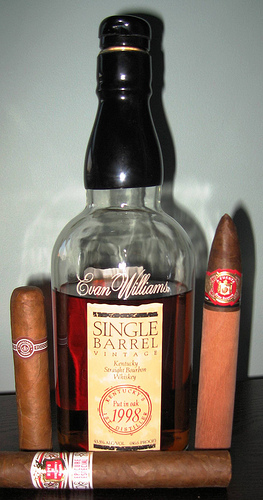 Named for the Bluegrass State’s first distiller, Evan Williams is the number two seller of Kentucky straight bourbon whiskey in the U.S. (the first being Jim Beam). It is distilled and bottled at the Old Evan Williams Distillery in Bardstown, Kentucky, where Parker and Craig Beam oversee production. Corn, rye, and barley from local farmers are the main ingredients, as is a strain of yeast that has been in the Beam family for eight generations.
Named for the Bluegrass State’s first distiller, Evan Williams is the number two seller of Kentucky straight bourbon whiskey in the U.S. (the first being Jim Beam). It is distilled and bottled at the Old Evan Williams Distillery in Bardstown, Kentucky, where Parker and Craig Beam oversee production. Corn, rye, and barley from local farmers are the main ingredients, as is a strain of yeast that has been in the Beam family for eight generations.
Like the name suggests, each bottle from the Single Barrel line originates from one specially selected barrel, which is why the bottles vary in color and flavor both within and between years. The whole idea is to create a “unique taste experience.†In line with that goal, each bottle comes complete with two born-on dates: one for the day it was placed in a charred white oak barrel to age, and one for the day it was bottled. The bottle sampled for this tasting was barreled on November 9, 1998, and bottled on June 12, 2008.
This practice of creating a new vintage every year has helped Evan Williams accumulate plenty of accolades, including “Whiskey of the Year†(The Spirit Journal, 1990) and “Spirit of the Year†(Food & Wine, 1992).
The Vintage 1998 incarnation is no exception. It earned a silver medal at the 2008 San Francisco World Spirits Competition, where it was heralded as “one of the best whiskey bargains around†and “a stylish and charming whiskey.†And Wine Enthusiast recently wrote it is “elegant and austere.â€
This is, without a doubt, no rail spirit, and that becomes clear as the bourbon takes on a golden amber hue in the glass. With a slightly milky consistency—especially on the rocks—it presents a clean nose of butter, lemon, banana, and hay. The taste of melon, honey, and sugar is highlighted by a calming butterscotch finish. A spicy tingle creeps up at the very end, almost as if to remind you to take another sip.
While the flavor is big enough to stand up to most cigars, I think medium-bodied smokes pair best. Spice is a bonus, helping to offset some of the bourbon’s sweetness. Excellent compliments include the H. Upmann Signature, Cuban Crafters Cubano Claro, La Aurora Barrel Aged, and the Hoyo Epicure Especial.
Whatever you smoke, though, I think you’ll agree that the Evan Williams Single Barrel Vintage 1998 is an outstanding sipping bourbon—a far cry from any rail spirit. And with a price tag in the range of $25-35 per 750 ml. bottle, you needn’t fear buyer’s remorse.
photo credit: Stogie Guys

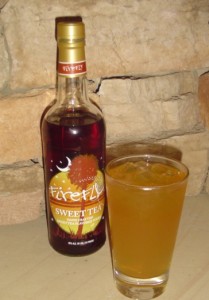 Firefly is a unique drink that is taking the Southeast by storm. Made on Wadmalaw Island, 30 miles south of Charleston in South Carolina, it is distilled four times and infused with tea from a plantation only a few miles from the distillery. Then, to get that distinctive sweet tea taste, they blend it with Louisiana sugar cane.
Firefly is a unique drink that is taking the Southeast by storm. Made on Wadmalaw Island, 30 miles south of Charleston in South Carolina, it is distilled four times and infused with tea from a plantation only a few miles from the distillery. Then, to get that distinctive sweet tea taste, they blend it with Louisiana sugar cane.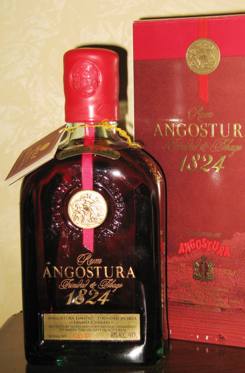 This highly esteemed rum honors the year Angostura got its start as a maker of concentrated food and beverage flavorings. The Trinidad & Tobago-based company’s beginnings can be traced back to 1824 when a surgeon general in
This highly esteemed rum honors the year Angostura got its start as a maker of concentrated food and beverage flavorings. The Trinidad & Tobago-based company’s beginnings can be traced back to 1824 when a surgeon general in 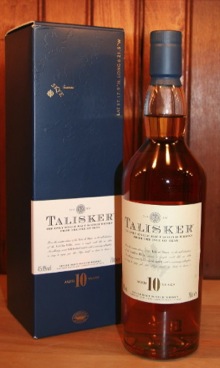 The Talisker 10 Year is dominated by peatiness, which makes it a Scotch that not everyone will like, but some will love. The peaty flavor comes from the distinctive terrain that surrounds the Talisker, the only Scotch Whisky distillery on the Isle of Skye in West Scotland.
The Talisker 10 Year is dominated by peatiness, which makes it a Scotch that not everyone will like, but some will love. The peaty flavor comes from the distinctive terrain that surrounds the Talisker, the only Scotch Whisky distillery on the Isle of Skye in West Scotland.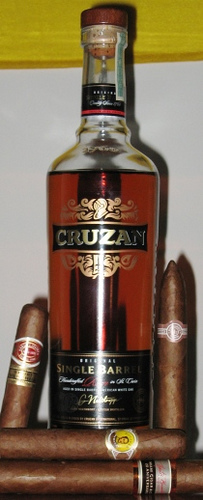 That history is rich and varied. The island has been controlled by seven different nations since Christopher Columbus first landed on St. Croix’s shores in 1493 (Spain, England, Holland, France, Malta, Denmark, and now America). It thrived due to sugar output, which made it a naturally fitting locale for rum production. And even though cane is no longer grown on St. Croix, Cruzan’s business is supported by molasses imports.
That history is rich and varied. The island has been controlled by seven different nations since Christopher Columbus first landed on St. Croix’s shores in 1493 (Spain, England, Holland, France, Malta, Denmark, and now America). It thrived due to sugar output, which made it a naturally fitting locale for rum production. And even though cane is no longer grown on St. Croix, Cruzan’s business is supported by molasses imports. Stagg is a beast of a bourbon, bottled at full cask strength and unfiltered from barrel to bottle. While the exact strength varies with each annual release, the bourbon is noted for its high proof, with some people even referring to it as “Hazmat” because it is illegal to transport on airplanes due to its high alcohol content (and thus flammability).
Stagg is a beast of a bourbon, bottled at full cask strength and unfiltered from barrel to bottle. While the exact strength varies with each annual release, the bourbon is noted for its high proof, with some people even referring to it as “Hazmat” because it is illegal to transport on airplanes due to its high alcohol content (and thus flammability).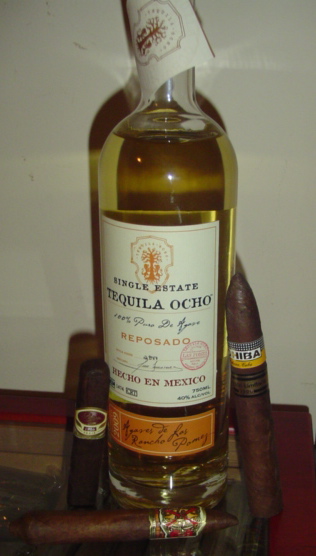 Tequila Ocho is the first single estate vintage tequila to be introduced in the U.S. That means all the agave plants used—100% blue agave—are grown on a single plot of land and, like vintage bourbon, from a single harvest (in this case 2008).
Tequila Ocho is the first single estate vintage tequila to be introduced in the U.S. That means all the agave plants used—100% blue agave—are grown on a single plot of land and, like vintage bourbon, from a single harvest (in this case 2008). Patrick Ashby
Co-Founder & Editor in Chief
Patrick Ashby
Co-Founder & Editor in Chief Patrick Semmens
Co-Founder & Publisher
Patrick Semmens
Co-Founder & Publisher George Edmonson
Tampa Bureau Chief
George Edmonson
Tampa Bureau Chief